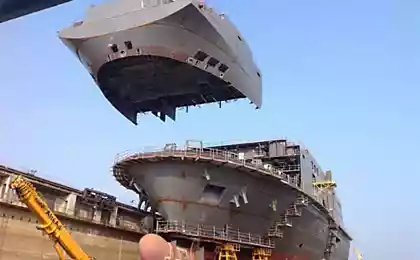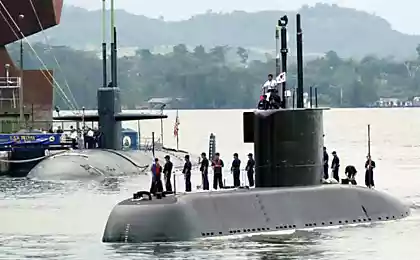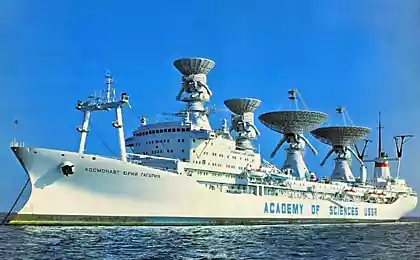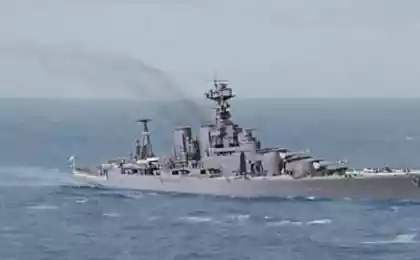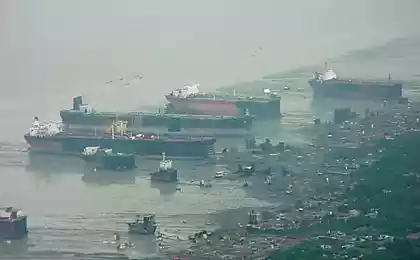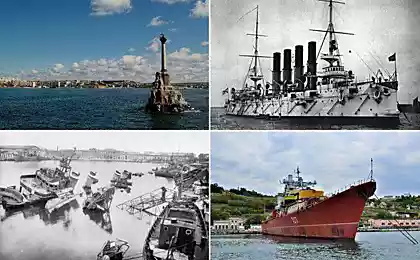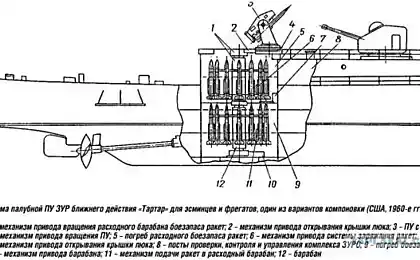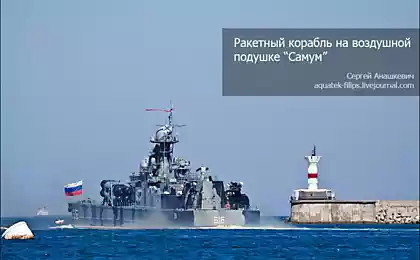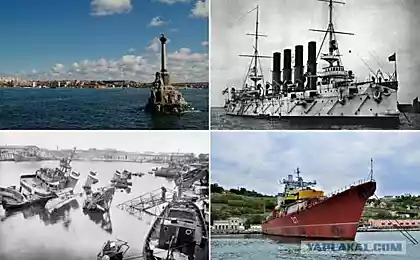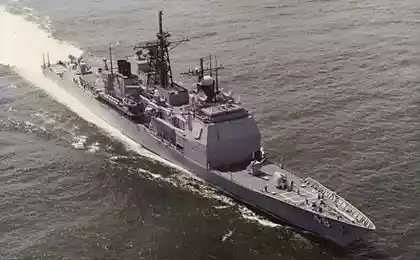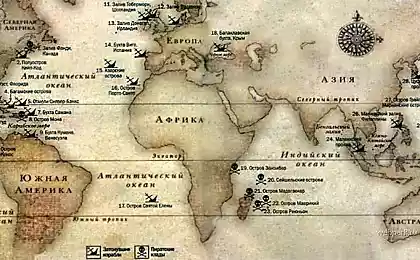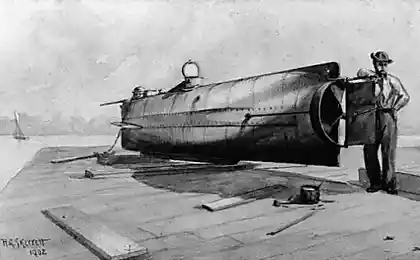2467
10 ships that Shook the World
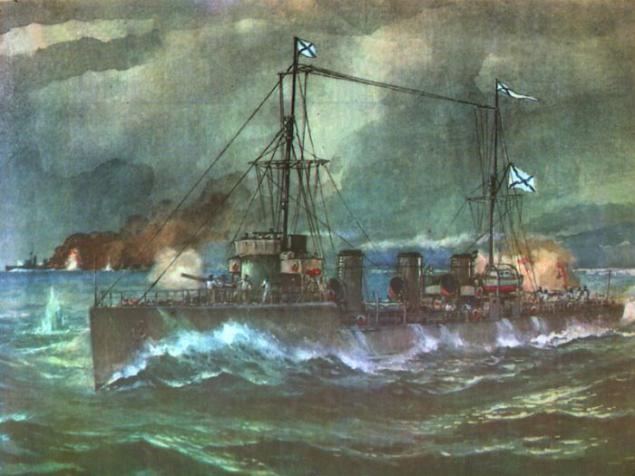
October 5, 1913 on a granite embankment of the Neva was particularly crowded. An unusual cluster of residents of St. Petersburg called the handsome ship - destroyer "Novik". Of course, the general public has come here to admire its beautiful architecture, but experts and knowledgeable people just thought she was not the main advantage - the main was that the emergence of the "Novik" marked a genuine revolution in the development of this class of ships. It is the "Novik" initiated the construction of a new type of destroyers in all navies of the world.
It should probably be recalled that before the First World War minonosnye ships were two suborders: the actual destroyers and kontrminonostsy. And the German destroyers, created exclusively for torpedo attacks as part of the fleet, armed with powerful ideas on the time torpedoes. German artillery unduly neglected - they believed that the combat stability of the connection must provide light cruiser - the leader of destroyers. Equally dismissive treated German shipbuilders and military radio equipment - it was assumed that the ships of this type should not be used either for exploration or for the production of minefields. However, the German destroyers are fast, seaworthy and sufficiently large cruising range.
Its type destroyer consistently developed and the British, and the British artillery on ships has traditionally been more powerful than the German "torpedo". And in English samples was constantly increasing artillery armament of destroyers and other navies around the world. All except the Russian ...
The new destroyer was built on donations collected by the population of Russia during the Russian-Japanese war. From these "special committee to strengthen the navy 'best competitive projects was the development of the shipbuilding technical office Putilov. It compared favorably with other very low specific fuel consumption through the use of oil heating boilers and high efficiency, as well as the compact power unit - a steam turbine, and progressive design use set of longitudinal ship and high-strength steel. All this has allowed a moderate displacement and high speed craft equip heavy artillery and torpedo armament and very advanced for that time radio station providing communication at distances up to 300 miles.
Ceremonial laying of the body "Nowina" held August 1, 1910 at the Putilov shipyard, and July 4, 1911 the ship safely into the water. Began assembling machinery and armament of the ship. Mooring trials began April 25, 1912, six weeks before the contract term.

It was quite an unusual ship: the destroyer, who became the founder of the original concept of the ships of this type. Designers not only borrowed all that was best in the English and German destroyers, but went further - to the universal torpedo-gun ships with a displacement of 1,500 tons, with the maximum possible number of torpedo tubes and rate of 102-mm guns, as well as a device for setting minefields.
By artillery armament "Novik" about twice the size of the biggest destroyers of the era. However, its firepower is determined not by the number of guns, and the rational organization of the shooting. The fact that the four semi-automatic guns 'News' had a central tip artillery. In addition, they were significantly superior to the British 102 mm gun and the initial velocity and mass of the projectile, and the firing range.
Equally formidable was torpedoes Russian destroyer: it vosmitorpedny broadside proved more powerful than the two latest foreign destroyers. Ability to conduct torpedo firing salvo did "Novik" one of a kind vehicle. Such a high concentration of weapons and special equipment required - central control devices firing torpedoes.
I should add that "Novik" had arrangements for setting minefields. To do this, on the upper deck at the stern of the ship laid mine rails, to which were attached turnbuckles mines. In setting up barriers mines drove to the stern and dropped into the water.
Well, of course, the most striking difference between "Novik" from other ships lay in its speed - long Russian destroyer was the fastest ship in the world. And the primacy of the "Novik" (37, 3 knots!) Remained until 1917.
Thus, due to the wide destroyer universalism and great combat power has become a formidable opponent for surface ships of all classes and types. Such "Novik" combat units were in a foreign navies during the First World War.

The British, though, and sought to strengthen the artillery weapons destroyers, however equip destroyers only three 102-mm cannons and four 533-mm torpedo tubes. Four 102-mm guns had only "leaders", while the Baltic "Novik" all had the same number of guns and destroyers series "Izyaslav" was already five of these guns.
Only during the war, the British still have understood that recharge in combat torpedo extremely difficult. This led them to strengthen their torpedoes newest destroyers from four to six tubes. And this at a time as the first "Novik" was eight torpedo tubes, while the destroyers "Ushakovka" series even twelve!
Again, during the war, at the beginning of 1916, the British realized the need to provide destroyers and means for setting minefields. And to compensate for the weight of the mines laid on the upper deck, the ship had to shoot the cannon fodder and fodder twin-tube torpedo tube. After this last 12 hours of surgery destroyer could take 40, and the leader - 60 min barrier. Well, "Novik" was originally calculated on the ball 60 minutes!
When the First World War, "Novik" was the only one in the Russian Navy ship of this type. His combat characteristics so dramatically different from the corresponding data of other destroyers that he was admitted to the ... cruisers of the Baltic Fleet, which included and started World War II.
In his first combat sortie in conjunction with the cruiser "Novik" was released September 1, 1914, when a large wave of forced rest destroyers return to Skerries. With German Russian ships cruising patrol met the next day. The enemy immediately began to retreat. Forty minutes persecuted "Novik" light cruiser "Augsburg", but a big swell is not allowed to overtake the enemy.
Since the second half of September 1914, the Baltic Fleet has started an active mine productions in enemy waters, which has been isolated detachment destroyers special purpose - "General Kondratenko", "border guard", "Siberian shooter" and "Hunter". "Novik" was assigned to the squad leader. Minelaying were in the south-western and southern parts of the Baltic Sea, which had great significance for Germany. The fact that the Nile bay with adjacent areas during the First World War was the site of the combat training of all Kaiser fleet and a violation in this place sailing ships combat capability significantly undermined. Here, in the south-western part of the Baltic Sea, maritime routes converged German transports, and on the security of the work of many ways dependent on steel and weapons factories.
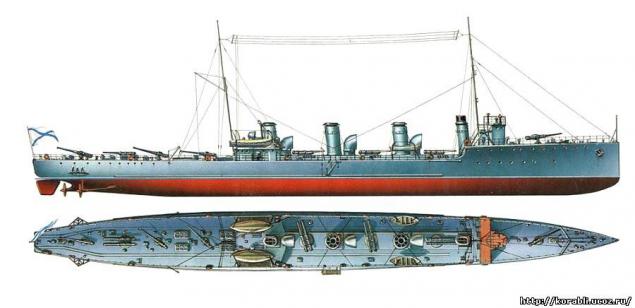
Minelaying special detachment covered, as a rule, the second division of destroyers. But "Novik" often acted independently of its operation does not provide additional strength. The hope was stealth action and high speed craft. Course and speed were chosen so that the destroyer, following offshore, managed to lay mines during the dark time of day and in the morning to return to its shores.
Considering that the material base of the Russian fleet is weak and it can not present any particular risk, the Germans did not keep constant reconnaissance and surveillance in the most important areas for them. This facilitated our sailors minelaying in enemy waters. As a result, November 5, 1914, 12 days after mining, exploded and sank armored cruiser "Friedrich Karl". For the German command it was a complete surprise; the enemy has decided that the cruiser submarine torpedoed because they do not even admit the thought of Russian mine productions in these waters.
In August 1915 the German Navy once again tried to break into the Gulf of Riga. To do this, have focused tremendous force: 2 battleships, 4 cruisers, 33 destroyers, minesweepers Division 4, a significant number of patrol ships and support vessels. Detachment breakthrough covered 10 dreadnoughts, 5 armored cruisers and 32 destroyers. But the German Navy minesweeping operation hampered by skilful actions battleship "Glory." Frustrated by failures of the German High Command sent a night of 17 August, the Gulf of Riga newest destroyers V-99 and V-100, which was ordered to find and sink the ship torpedoes Russian. And in almost total darkness, the Germans suddenly faced with two destroyers. These were the "General Kondratenko" and "Hunter". A fight broke out, but opponents quickly lost sight of each other. In 23 hours, "Novik", who was at that time out of Irben Strait received a telegram from the "General Kondratenko." It was necessary to prevent the enemy's attempts to force entry into the bay, so the sailors quickly got ready to repel the attack. Anxious time dragged on ... 1 hour 10 min. German destroyers were suddenly illuminated with spotlights "Ukraine" and "Host". Only three minutes to continue the fight. From a distance of 600 m Russian gunners have a few hits, but two were released destroyer torpedo passed under the keels of German ships. But opponents missed again soon, which favored only the dark night. The Germans had no doubt the failure of his enterprise and waited dawn in order to get out of the Bay Area through the minefields.
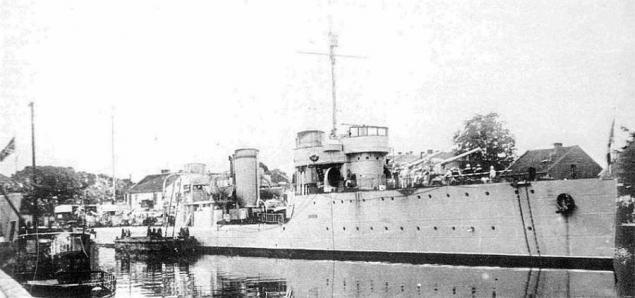
Waiting for the morning and "Novik". And here in the predawn darkness Mikhailovsky lighthouse signalers noticed two destroyers, marching in full swing forward. Raised on identification signals no answer. All doubts have disappeared - they were the best destroyers of the German Navy V-99 and V-100, which had a speed of 35, 5 knots. Their total armament was eight 88-mm guns and twelve torpedo tubes. However, the Russian sailors did not flinch. They knew perfectly well his ship, his artillery, and opportunities. This assurance was given a grueling workout, when the sailors threw for hours in heavy steel billet vents chetyrehdyuymovok. For in the central tip artillery shots were fired volleys in order to take the enemy in the "plug", and then - fire at a maximum rate of fire. After the first charging covering converted into ordinary loaders - now the number of shells fell on the enemy depended on their skill and physical endurance.
"Novik" first opened fire from a distance of 8700 m. The enemy destroyers turned and began to rapidly respond across the board, but their shooting was ineffective. However, the Germans immediately became very clear with whom they will have to deal with. The third salvo "Novik" covered head V-99 and moved to the rapid fire. A cloud of smoke and steam enveloped the ship, a fire broke out on the quarter-deck and fell chimney, bright flame seemed and stern. V-100 hastened to put a smokescreen, and the Germans began to retreat. Now she "Novik" transferred the power of their guns on the V-100 and quickly set it on fire. Shooting the enemy became disordered. Alternately striking fire both destroyers "Novik" maneuvering, hoping to drive the enemy on the Russian minefield. And soon he succeeded. Under the V-99 there was a dull explosion mine, then another, and the ship disappeared into the gray waves of the Baltic Sea. V-100, with heavy damage, barely left the shelter of the main forces. "Novik" is practically not affected and losses in personnel did not.
This victory was followed by a series of not less than outstanding military success "Novick." Evening of November 7, 1915, following at the head of the ship found at banks Spon patrol boat "Norburg." Rapid fire "Novick" in seconds paralyzed patrol and then a torpedo sent it to the bottom.
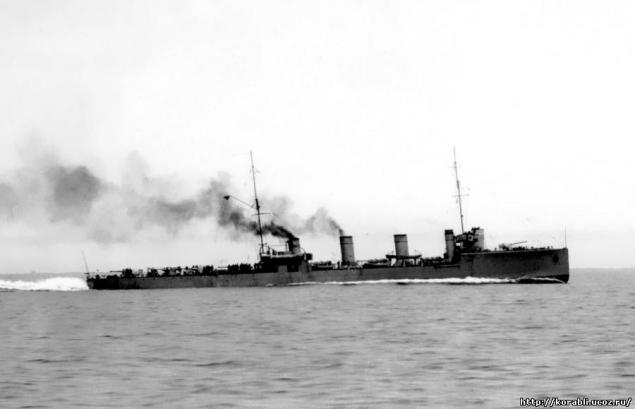
Baltic Fleet intensively continued his barrage of mine operations, and "Novik" in these campaigns was one of the most active participants. Night minelaying required special courage and high combat training of the crew, especially navigators since had to maneuver in the areas of German and their own minefields. But mine had to stand in the most unexpected places for the enemy, and so as soon as dusk descended, overloaded destroyers hastened to enemy shores. Soon the detachment commander of the fleet received a telegram: "The Navy is informed that the evening of 4 December, we sank in the Baltic Sea cruiser" Bremen "and a great destroyer." From the official announcement of the German command, it became clear that these two ships were lost on mines laid by "Novick." The success of the Russian minefields determined not only by the number of damaged and lost ships Kaiser fleet, and to the impact that the combat activities of the German navy and shipping in the southern part of the Baltic Sea.
On the night of May 18, 1916 destroyers "Novik", "Thunder" and "Winner" undercover cruiser "Rurik", "Oleg" and "Hercules" made a daring raid on a German convoy in Norchepingskoy bay. In this battle, Russian destroyers for the first time in the world used the torpedo salvo firing on the area. Enemy force of 20 ships were scattered, auxiliary cruiser "Herman", two armed trawler and two steamers - sunk.
In October 1917, the destroyer participated in the Battle of Moon Sound with the German fleet, bursting to revolutionary Petrograd, then went to him and found remont.Tam revolution.

The revolutionary events turned not only a national tragedy of fratricide, they have become a disaster for the Navy. It so happened that the fleet has become a bargaining chip in the political game of the day. For this game, he paid with his death. June 18, 1918 in Novorossiysk on the orders of Lenin were flooded almost all the ships of the Black Sea Fleet. One of the seven class destroyers "Novik" destroyer "Kerch" their torpedoes sank the battleship "Free Russia" and several other ships, and then the crew opened the Kingston and flooded the warship. Happened what the enemy could not achieve throughout the war.
Destroyer "Novik" was not involved in the civil war. Before 1925, the destroyer was in the port escorted. In 1926 the ship was rearmed and given a new name "Yakov Sverdlov." With this name, he became a member of the academic unit of the Baltic Fleet. However, the real name of the destroyer is still the name of "Novik". It also does not otmenimo as human ancestry and country, as the glory gained in battle.
"Novikov" ships were centenarians. Some of them survived until the mid-50s. They successfully have served not only in the Baltic, but also in the North, Pacific and Black Sea fleets.
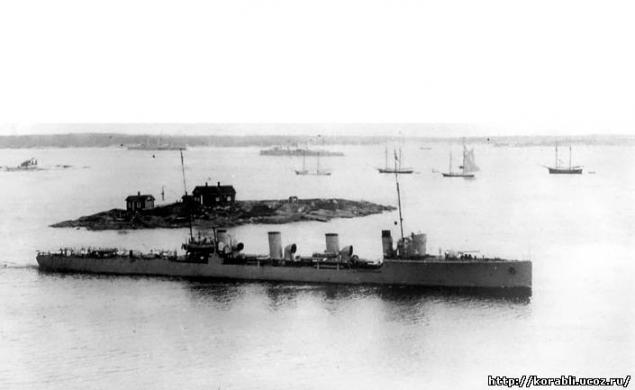
In the military fate of the "Novik" as the military fate of the entire country was destined to continue. June 22, 1941 a new war on the Soviet Union collapsed. Destroyer "Novik" getting back to defend their fatherland. From the first days of the Great Patriotic War the legendary ship on fire fighting puts minefields, provides outposts battleship "October Revolution" in its transition to Kronstadt, participates in the defense of the fleet's main base in Tallinn. When German troops reached the outskirts of Tallinn Naval Command was decided to relocation of the fleet in Kronstadt. August 27 to otlechit the enemy's attention was a counterattack along the entire front. At this time began loading on warships and by the evening of the same day they left Tallinn raid. It was a tough transition. More than 200 warships and transports had to pass the narrow Gulf of Finland about 160 miles, 64 miles of which was mined, and 26 miles on both sides were occupied by the enemy. Lacked minesweepers, air cover was not. Destroyer "Novik" and his associates destroyers cruisers provided protection and transport. Had hard - on the way there was a huge number of mines. Minesweepers and "Sea Hunter" did not have time to shoot mines surfaced after trawling. The air was seething with German planes. But ships bravely continued on their way.

